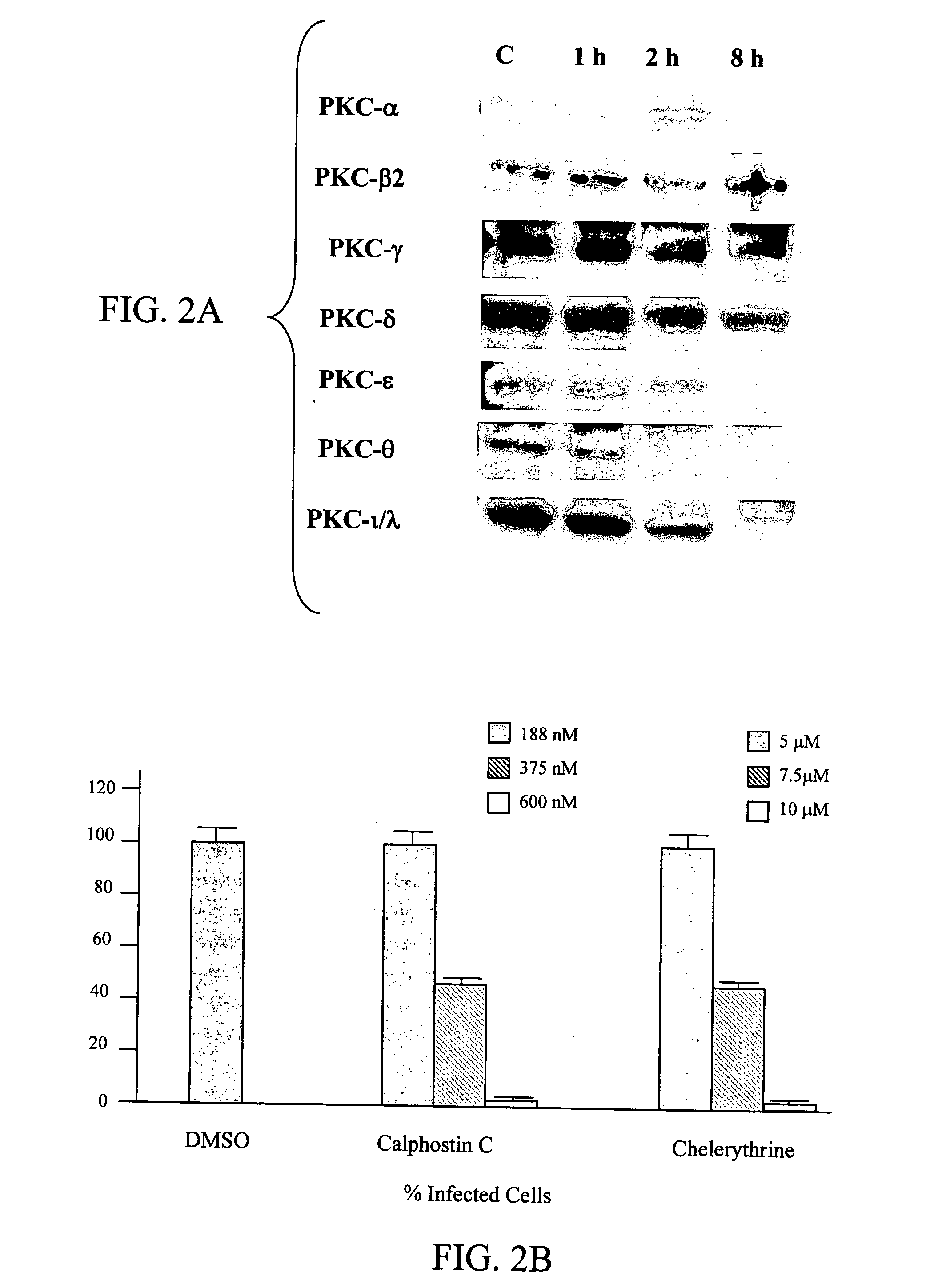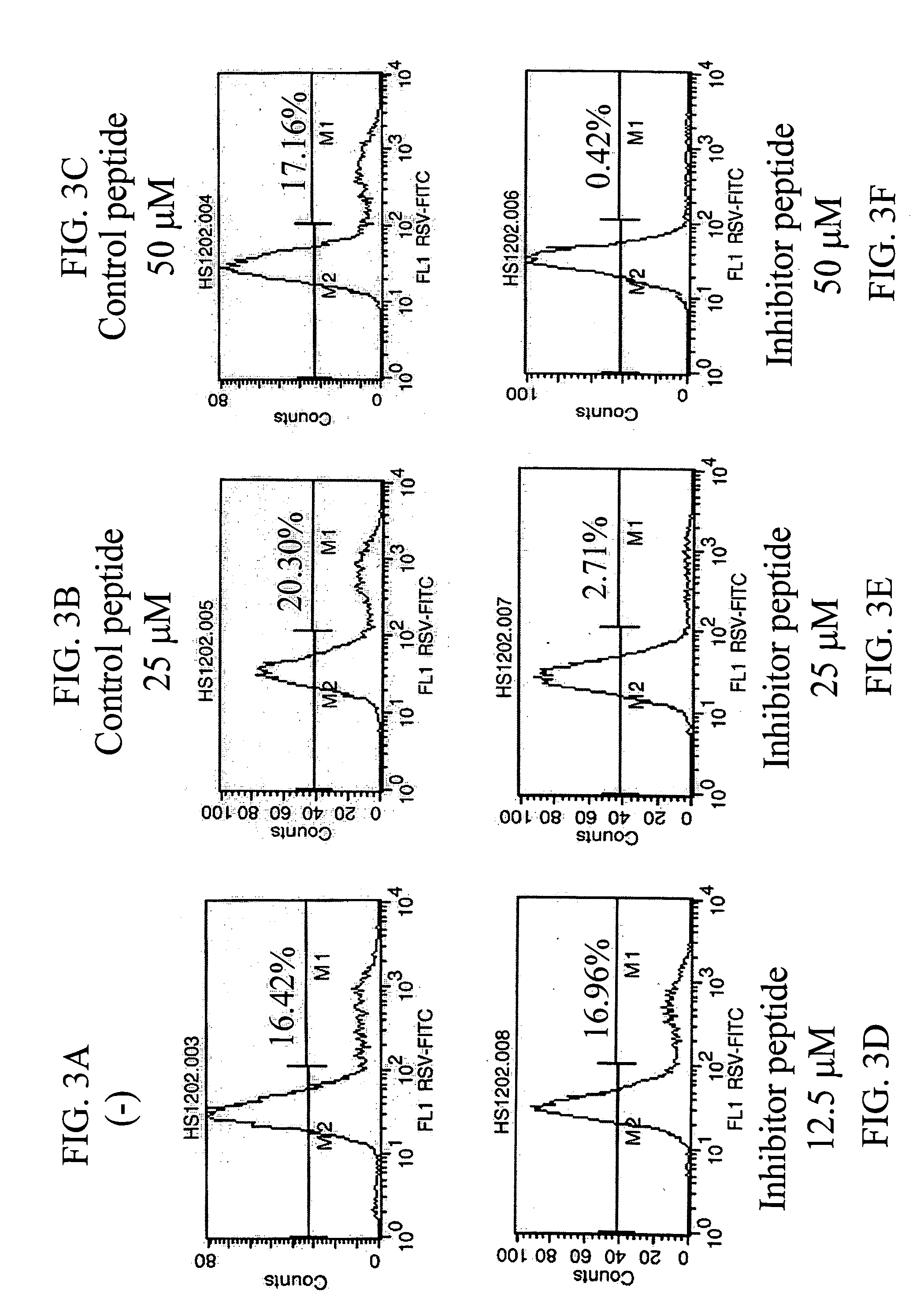Protein kinase C as a target for the treatment of respiratory syncytial virus
a technology protein kinase c, which is applied in the field of protein kinase c as a target for the treatment of respiratory syncytial virus, can solve the problems of human primary epithelial cell involvement and prolonged hospitalization of high-risk individuals, and achieve the reduction of endogenous levels of pkc activity, pkc zeta activity, and/or pkc theta activity
- Summary
- Abstract
- Description
- Claims
- Application Information
AI Technical Summary
Benefits of technology
Problems solved by technology
Method used
Image
Examples
example 1
[0080] Requirement of Different Signaling Elements for Successful RSV Infection in Primary NHBE Cells
[0081] To determine if different signaling molecules related to the ERK pathway are required for a successful RSV infection, primary NHBE cells were exposed to various inhibitors previously to being infected with a sucrose-purified RSV preparation. Exposure of NHBE cells to AG490, PD98059, and Ro318220 caused a significant reduction in the number of infected cells, while Wortmannin did not have an effect on viral replication, as shown in FIGS. 1A and 1B. These results strongly suggest that JAK, ERK-1 / 2, and PKC, but not PI-3K, are required for a successful RSV infection in bronchial epithelial cells. The fact that the highest reduction in percentage of infected cells was seen with PKC inhibitor suggests that initial events following RSV exposure may involve PKC activation. A previous report implicated PKC.zeta. in the early stages of RSV infection in A549 cells and suggested that it ...
example 2
[0082] PKC Inhibitors Block RSV Infection
[0083] A previous report indicated that several PKC isozymes are activated at early and late stages of RSV infection in A549 cells, there is no report if any of the PKC isozymes is required for an efficient RSV infection. The possibility whether PKCs are involved in normal human epithelial cells was tested in cultures of primary cells, normal human bronchial epithelial cells. Results show that NHBE cells express PKC-.alpha., .beta.2, .gamma., .delta., .epsilon., .theta., .iota., and .lambda. (FIG. 2A) and a time course assay demonstrated that RSV infection caused changes in the levels of different PKC isozymes at different time points. Such changes are reflected in the reduction of the expression of these PKC isoforms, suggesting the previous activation of these isozymes. Moreover, PKC inhibitors, Calphostin C, and Chelerythrine reduced in a dose-dependent manner the number of infected cells (FIG. 2B) in which 50% inhibition was reached at co...
example 3
[0086] PKC-.alpha. Activation and its Translocation to Cell Membrane Induced by RSV
[0087] To determine the location and phosphorylation status of PKC-.alpha. by immunocytofluorescence and confocal microscopy, NHBE cells were exposed to RSV at an infectious dose of 20 MOI. PKC-.alpha. was first studied because of the role that this isozyme plays during the formation of the caveolae, which has been indicated as a required system for both RSV infection and maturation. PKC-.alpha. translocates from the cytoplasm to the cell plasma membrane and colocalizes with viral particles as early as 10 minutes after exposure to RSV (FIGS. 4A-4F). PKC-.alpha. colocalizes with the viral particles up to 1 hr at the cell membrane. Whether the persistence of co-localization is due to the binding of new viral particles to the cells or the formation of a stable complex is unknown at the present time. Several studies have demonstrated that autophosphorylated PKC-.alpha. migrates to the cell membrane for fu...
PUM
| Property | Measurement | Unit |
|---|---|---|
| time | aaaaa | aaaaa |
| time | aaaaa | aaaaa |
| time | aaaaa | aaaaa |
Abstract
Description
Claims
Application Information
 Login to View More
Login to View More - R&D
- Intellectual Property
- Life Sciences
- Materials
- Tech Scout
- Unparalleled Data Quality
- Higher Quality Content
- 60% Fewer Hallucinations
Browse by: Latest US Patents, China's latest patents, Technical Efficacy Thesaurus, Application Domain, Technology Topic, Popular Technical Reports.
© 2025 PatSnap. All rights reserved.Legal|Privacy policy|Modern Slavery Act Transparency Statement|Sitemap|About US| Contact US: help@patsnap.com



